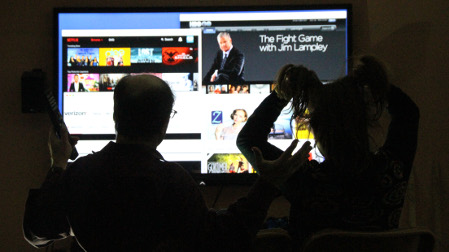The Challenge of Search and Discovery
NEW YORK—Sometimes too much of a good thing is not a good thing. My wife and I recently wanted to watch a movie when we found ourselves with about two hours between car pool sessions. I was interested in action or comedy, she wanted a drama or perhaps something we had missed in the theaters. We’re fortunate to be blessed with a wealth of choices: HBOGo, Netflix and Amazon Prime accounts, not to mention our Fios on Demand subscription.
The result of all those options? It took us more than 45 minutes to pick our movie (“Sleeping with the Enemy” with Julia Roberts). The protracted search effort ate into our limited viewing window. Instead of a relaxed experience we had to pause for car-pool duty, spoiling whatever mood this decidedly non-romantic thriller might have presented.

“Why isn’t this easier?”
Not unexpectedly, I am not the only one with this question. At the recent Next:TV Summit it was apparent that the debate about the future of television is still raging. There was one near universal point of agreement among the many speakers and guests at the conference and it was that the filter is definitely “broken,” as pointed out by Clay Shirky of NYU as far back as 2008.
I agree. In fact, I suspect that we binge view content simply because good content is so hard to find. When we find something at all palatable, we cling to it like a life raft for as long as possible.
Yes, Netflix has its recommendation engine. HBO's EVP of technology and chief digital officer Diane Tryneski says one is on the way for HBOGo. Each of those are fine, but neither solution addresses the scenario that my wife and I, as well as millions of others, experience daily: there’s no holistic way of searching across services.
A killer app would know what cable and OTT service I subscribe to, learn over time what I like and make recommendations which align with my tastes, mood, or other conditions. Ideally such an app would allow me to express interest in a movie currently in theaters too, then alert me when it becomes available on one of my services.
From the consumer’s perspective, it is almost astounding that this does not yet exist. For a more business-minded perspective, consider Jonathan Martaugh. The head of film & television for Facebook/Instagram, two companies that have more insight into what makes their audiences tick than just about anyone, expressed to the Next:TV Summit audience that content discovery may be the single biggest opportunity in TV.
IS APPLE TV THE ANSWER?
So is Apple TV the end of television as we know it or just one more set top box like all the others?
Erik Schwartz of BitTorrent TV cut through the noise for me through his experience with an early development Apple TV box. He explained, “it’s all about the apps.” His team was able to port his company’s iOS app to Apple TV in just one day. There are huge numbers of programmers and code libraries out there. No one should underestimate the number of third party apps that will quickly be available or the impact they will have on viewers.
Apple TV provides the best opportunity yet for someone to aggregate the huge number of choices available to a consumer and provide a unified and personalized search tool. Better yet, it could easily work across TV, Mobile and the Web. But Apple is not alone.
CHANGE IS COMING
The set top box is still king of linear TV. Given options however, consumers may look more closely at their bills, especially when 30 percent of a typical cable bill can be equipment fees. With cord cutters and programmers both applying pressure to the MVPDs, how long can this last?
Many MVPDs are beginning to realize that their SVOD content should be delivered via IP. Charter clearly gets this, as reflected with their recent announcement of a Roku app. This permits a convergence of head-end equipment for both SVOD and mobile users. I believe this change is just beginning.
ALL YOU GOTTA DO IS…
If we were to accept that the IP-based, application-rich device is the set top box of the future, it would not take a huge leap to envision someone coming out with the magic cross-platform search app. A company needs a user authentication system which identifies the subscribed-to services, a powerful robot scraping the available content from the myriad of providers, a recommendation engine, and some APIs to link to the content providers. Then tie the whole thing up in a cool interface via an elegant app that works on a set top box and mobile phones. Not simple, but easier than returning a stranded astronaut from Mars.
The app need not natively play the content. It would be sufficient to point to content and to know when the play is done. Asking after the play how the content matched the user expectations would provide critical knowledge about users and their habits. That is valuable data in the TV business. How valuable? At Next:TV there was significant discussion about using such information as currency in the distribution economy.
Attempts are already under way. NextGuide has an app that combines knowledge of linear MVPD offerings with some over the top content. Google is working on a new interface for Chromecast which should enhance navigation. Both Rovi and Watchmi are working on discovery apps for MVPDs, although one has to wonder what business case convinces an MSO to send viewers to competing OTT content? Watchmi says it is targeted advertising.
That’s going to take some convincing, but the dangers of not taking action are quickly becoming perilous. One thing is certain: content discovery is clearly the next frontier, so as they used to say, “stay tuned.”
Get the TV Tech Newsletter
The professional video industry's #1 source for news, trends and product and tech information. Sign up below.
